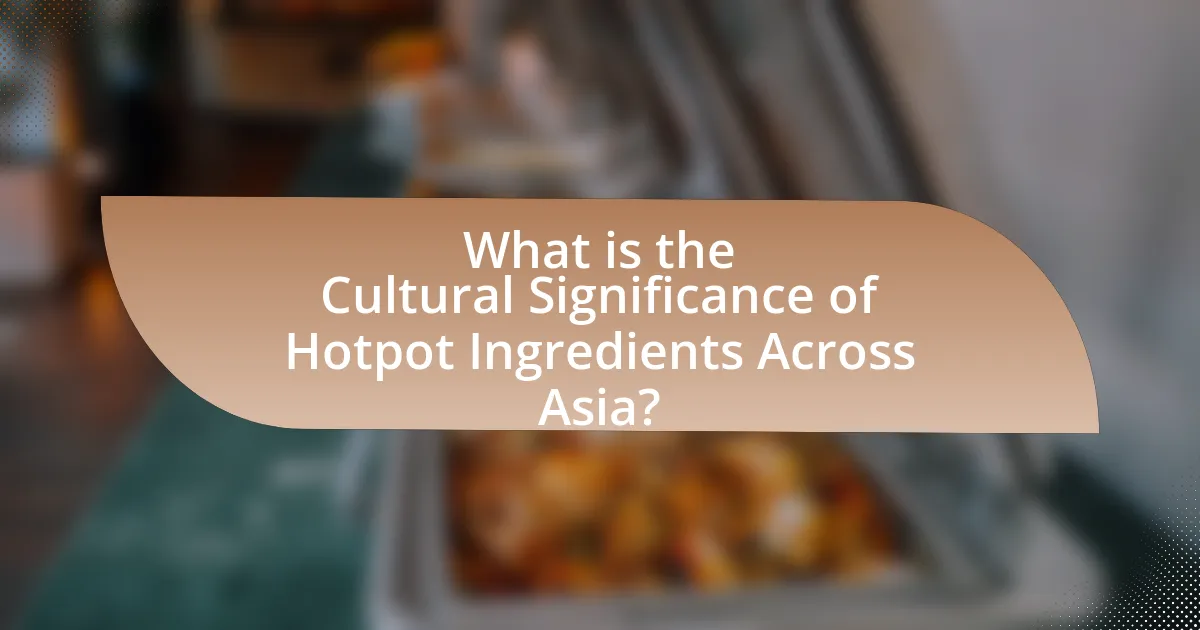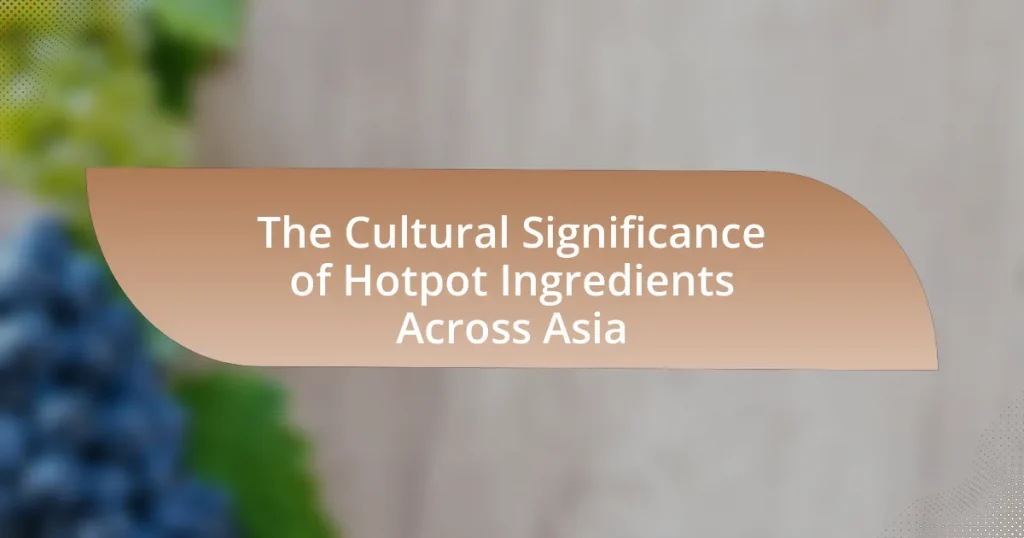The article explores the cultural significance of hotpot ingredients across Asia, highlighting their role in communal dining and regional diversity. It examines how ingredients reflect cultural identities, regional preferences, and historical influences, emphasizing the importance of local sourcing and seasonal variations. The discussion includes the health implications of different ingredients, the impact of modern dietary trends, and the economic effects of hotpot ingredient sourcing on local communities. Additionally, it addresses the challenges suppliers face in maintaining ingredient quality and offers tips to enhance the hotpot dining experience.

What is the Cultural Significance of Hotpot Ingredients Across Asia?
Hotpot ingredients hold significant cultural value across Asia, symbolizing communal dining and regional diversity. In countries like China, Japan, and Korea, hotpot serves as a social activity where families and friends gather, fostering relationships and cultural traditions. For instance, in China, the variety of ingredients reflects local agricultural practices and seasonal availability, while in Japan, shabu-shabu emphasizes the quality of meat and fresh vegetables, showcasing the importance of freshness in Japanese cuisine. Additionally, specific ingredients, such as mushrooms and tofu, are often associated with health and wellness, highlighting cultural beliefs in nutrition. The preparation and sharing of hotpot meals also reinforce social bonds, making it a vital aspect of cultural identity in these regions.
How do hotpot ingredients reflect cultural identities in different Asian countries?
Hotpot ingredients reflect cultural identities in different Asian countries by showcasing regional preferences, local ingredients, and traditional cooking methods. For instance, in China, the use of diverse meats, seafood, and vegetables in hotpot illustrates the country’s vast agricultural resources and culinary diversity, with variations like Sichuan hotpot emphasizing bold spices that reflect the region’s flavor profile. In Japan, the emphasis on fresh seafood and seasonal vegetables in shabu-shabu highlights the cultural value placed on freshness and simplicity, aligning with the Japanese aesthetic of harmony with nature. Similarly, in Korea, the inclusion of fermented ingredients like kimchi in hotpot signifies the importance of fermentation in Korean cuisine and its historical roots. These ingredient choices not only represent local tastes but also embody the cultural narratives and practices unique to each country, reinforcing their distinct culinary identities.
What role do regional ingredients play in defining local hotpot styles?
Regional ingredients are crucial in defining local hotpot styles as they reflect the unique culinary traditions and agricultural practices of each area. For instance, Sichuan hotpot prominently features spicy ingredients like Sichuan peppercorns and local vegetables, which are integral to the region’s flavor profile. In contrast, Cantonese hotpot emphasizes fresh seafood and lighter broths, showcasing the coastal region’s access to diverse marine life. This variation illustrates how local availability of ingredients shapes the preparation and taste of hotpot, making it a cultural expression of the region’s identity and resources.
How do historical influences shape the choice of hotpot ingredients?
Historical influences significantly shape the choice of hotpot ingredients by reflecting regional agricultural practices, trade routes, and cultural exchanges. For instance, the introduction of certain vegetables and meats in various Asian countries can be traced back to historical trade interactions, such as the Silk Road, which facilitated the exchange of diverse food items. Additionally, local climate and geography have historically dictated which ingredients are available, leading to variations in hotpot recipes across regions. In China, for example, the use of lamb in Mongolian hotpot is rooted in the nomadic lifestyle of Mongolian herders, while Sichuan hotpot features spicy ingredients influenced by the region’s agricultural abundance and culinary traditions. These historical contexts not only determine ingredient availability but also influence flavor profiles and cooking methods, showcasing the deep cultural significance of hotpot across Asia.
Why is hotpot considered a communal dining experience in Asian cultures?
Hotpot is considered a communal dining experience in Asian cultures because it encourages shared participation in cooking and eating. This interactive style of dining fosters social bonding, as diners gather around a shared pot to cook various ingredients together, promoting conversation and connection. The practice is rooted in traditions where meals are seen as opportunities for family and friends to come together, enhancing the communal aspect of dining. In many Asian cultures, such as Chinese and Japanese, hotpot meals often symbolize unity and harmony, reflecting the cultural value placed on togetherness during meals.
How does the sharing of ingredients enhance social bonds during meals?
Sharing ingredients during meals enhances social bonds by fostering collaboration and communication among participants. When individuals contribute ingredients to a communal dish, such as hotpot, they engage in a shared experience that promotes interaction and strengthens relationships. This practice encourages conversation, as diners discuss preferences and cooking times, creating a sense of togetherness. Research indicates that communal dining experiences, like those involving shared ingredients, lead to increased feelings of belonging and connection among participants, as evidenced by studies showing that shared meals can enhance social cohesion and emotional well-being.
What cultural rituals are associated with hotpot dining?
Hotpot dining is associated with several cultural rituals that emphasize communal eating and social bonding. In many Asian cultures, such as Chinese and Mongolian, hotpot is often enjoyed during family gatherings and celebrations, symbolizing unity and togetherness. The ritual typically involves diners cooking their own ingredients in a shared pot, which fosters interaction and collaboration among participants. Additionally, in some cultures, specific ingredients are chosen for their symbolic meanings, such as fish for abundance or mushrooms for longevity, enhancing the cultural significance of the meal. These practices highlight the importance of food as a medium for connection and cultural expression.
What are the common ingredients used in hotpot across Asia?
Common ingredients used in hotpot across Asia include various meats, seafood, vegetables, and noodles. Typically, thinly sliced beef, lamb, and pork are popular choices, while seafood options often feature shrimp, fish, and squid. Vegetables such as bok choy, mushrooms, and tofu are commonly included, along with noodles like rice vermicelli or egg noodles. These ingredients reflect regional preferences and cultural practices, as seen in the diverse hotpot styles across countries like China, Japan, and Korea, where each region emphasizes its unique flavors and cooking methods.
How do meat and seafood choices vary by region?
Meat and seafood choices vary significantly by region due to cultural preferences, availability, and local culinary traditions. For instance, in East Asia, particularly in countries like China and Japan, seafood such as fish, shrimp, and shellfish is prevalent, reflecting the coastal geography and fishing traditions. In contrast, regions like Central Asia and parts of the Middle East favor lamb and beef, influenced by pastoral lifestyles and nomadic herding practices. Additionally, in Southeast Asia, a diverse array of meats, including chicken and pork, is common, often accompanied by a variety of spices and herbs that reflect local agricultural practices. These regional variations are supported by historical dietary patterns and the availability of specific animal husbandry practices, which shape the culinary landscape across Asia.
What vegetables and herbs are typically included in hotpot recipes?
Hotpot recipes typically include a variety of vegetables and herbs such as napa cabbage, spinach, mushrooms, tofu, and scallions. These ingredients are chosen for their ability to absorb flavors and enhance the overall taste of the broth. For instance, napa cabbage is commonly used due to its tender texture and ability to soften quickly in hot broth, while mushrooms add umami flavor. Scallions not only provide a fresh taste but also contribute aromatic qualities to the dish. The inclusion of these specific vegetables and herbs reflects regional preferences and cultural significance in hotpot traditions across Asia.
How do hotpot ingredients symbolize seasonal and regional variations?
Hotpot ingredients symbolize seasonal and regional variations by reflecting local agricultural practices and climate conditions. For instance, in winter, hearty ingredients like root vegetables and meats are favored in colder regions, while summer hotpots often feature lighter vegetables and seafood, aligning with the availability of fresh produce. Additionally, specific regional preferences, such as the use of spicy ingredients in Sichuan hotpot or the incorporation of seafood in coastal areas, highlight the cultural and environmental influences on ingredient selection. This adaptability showcases how hotpot serves as a culinary representation of both the seasons and the geographical diversity across Asia.
What are the health implications of different hotpot ingredients?
Different hotpot ingredients have varying health implications, primarily influenced by their nutritional content and preparation methods. For instance, lean meats such as chicken and fish provide high-quality protein and essential omega-3 fatty acids, which are beneficial for heart health. Conversely, fatty cuts of meat can increase saturated fat intake, potentially raising cholesterol levels and the risk of cardiovascular diseases.
Vegetables commonly used in hotpot, like leafy greens and mushrooms, are rich in vitamins, minerals, and antioxidants, contributing to overall health and reducing the risk of chronic diseases. However, starchy ingredients such as noodles and dumplings can be high in carbohydrates, which may lead to weight gain if consumed in excess.
Additionally, the broth used in hotpot can significantly affect health; a broth high in sodium can contribute to hypertension, while a homemade, low-sodium broth can enhance the dish’s nutritional profile. Overall, the health implications of hotpot ingredients depend on their types, quantities, and preparation methods, emphasizing the importance of balanced choices for optimal health.
How do traditional beliefs influence the selection of ingredients for health benefits?
Traditional beliefs significantly influence the selection of ingredients for health benefits by guiding the understanding of which foods are considered nourishing or medicinal. In many Asian cultures, ingredients are chosen based on their perceived properties, such as warming or cooling effects, which are rooted in traditional practices like Traditional Chinese Medicine (TCM). For instance, TCM categorizes foods according to their energetic qualities and their effects on the body’s balance, leading to the selection of specific ingredients like ginger for its warming properties or goji berries for their health-promoting benefits. This selection process is often supported by historical usage and cultural narratives that emphasize the health benefits associated with these ingredients, reinforcing their importance in dietary practices.
What modern dietary trends are impacting hotpot ingredient choices?
Modern dietary trends significantly impacting hotpot ingredient choices include the rise of plant-based diets, health-conscious eating, and sustainability concerns. The increasing popularity of vegetarian and vegan lifestyles has led to a greater emphasis on plant-based ingredients such as tofu, mushrooms, and a variety of vegetables in hotpot offerings. Additionally, health trends focusing on low-carb and gluten-free options have prompted the inclusion of alternative ingredients like konjac noodles and gluten-free sauces. Sustainability concerns are also shaping ingredient choices, with consumers favoring locally sourced and organic produce to reduce environmental impact. These trends reflect a broader shift in consumer preferences towards healthier, more ethical eating habits.
What are the economic impacts of hotpot ingredient sourcing in Asia?
The economic impacts of hotpot ingredient sourcing in Asia include significant contributions to local economies, job creation, and the promotion of agricultural diversity. Sourcing ingredients for hotpot, such as meats, vegetables, and spices, stimulates demand in the agricultural sector, leading to increased production and sales. For instance, in countries like China and Japan, the hotpot industry supports millions of farmers and suppliers, enhancing their livelihoods. Additionally, the hotpot market, valued at over $30 billion in Asia, drives investments in logistics and distribution networks, further boosting economic activity. This sourcing also encourages sustainable practices as consumers increasingly prefer locally sourced and organic ingredients, fostering a shift towards environmentally friendly agriculture.
How do local farmers and markets contribute to hotpot ingredient availability?
Local farmers and markets significantly enhance the availability of hotpot ingredients by providing fresh, locally sourced produce and meats. This direct supply chain ensures that ingredients such as vegetables, mushrooms, and meats are harvested at peak freshness, which is crucial for the quality of hotpot dishes. For instance, farmers often grow specific varieties of vegetables that are traditionally used in hotpot, such as napa cabbage and enoki mushrooms, catering to local culinary preferences. Additionally, local markets facilitate the distribution of these ingredients, making them accessible to consumers and restaurants alike. This localized approach not only supports the economy but also fosters a connection between the community and its culinary heritage, ensuring that traditional hotpot recipes can be prepared with authentic ingredients.
What challenges do suppliers face in maintaining ingredient quality?
Suppliers face several challenges in maintaining ingredient quality, including inconsistent sourcing, environmental factors, and regulatory compliance. Inconsistent sourcing arises from reliance on multiple suppliers, which can lead to variations in ingredient quality due to differing farming practices or processing methods. Environmental factors, such as climate change and natural disasters, can adversely affect crop yields and ingredient availability, further complicating quality maintenance. Additionally, suppliers must navigate complex regulatory requirements that vary by region, which can impact the quality assurance processes they implement. These challenges are critical as they directly influence the overall quality of hotpot ingredients, which are essential for preserving the cultural significance of hotpot across Asia.
What tips can enhance the hotpot dining experience?
To enhance the hotpot dining experience, diners should focus on ingredient selection, broth variety, and communal sharing. Choosing fresh, high-quality ingredients such as thinly sliced meats, seasonal vegetables, and unique dipping sauces elevates the meal’s flavor and texture. A diverse selection of broths, ranging from spicy to mild, allows for personalized taste preferences and enhances the overall enjoyment. Additionally, the communal aspect of hotpot encourages social interaction, making the dining experience more engaging and enjoyable. Research indicates that shared meals foster stronger social bonds, which is particularly relevant in the context of hotpot dining, where the act of cooking together creates a sense of community.










